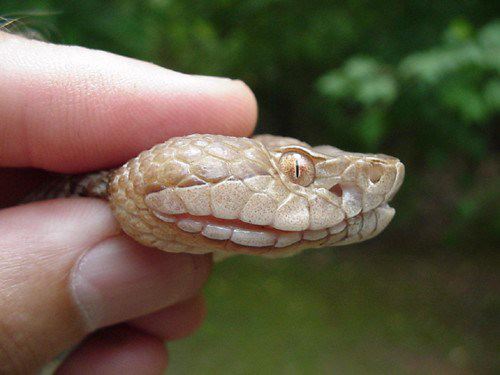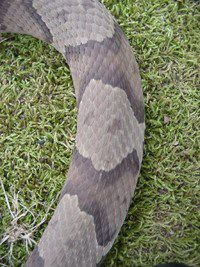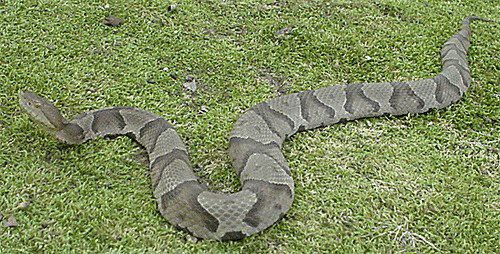some stuff bout my new baby lil new snake/mouse(pc mouse) The CopperHead by RAZER VENOMOUS Copperhead Snake The Copperhead is the most common venomous snake found in the eastern US. It is also known by the name "Highland Moccasin." As a species, it belongs to the genus "Agkistrodon" which also includes the Cottonmouth, also known as the "Water Moccasin". Copperheads are usually colorful and strikingly patterned snakes. They derive their name from the copper-like coloring of the head. The background color of the back and sides is tan to pinkish. There are darker, chestnut colored bands across the back and sides. Each band is of varing width, often described as hour-glass shaped. Newborn Copperheads are colored and patterned like adults, excepting the last inch of so of the tail which will be a bright, sulfur yellow color. Adults are usually in the range of 24 to 36 inches in length, although specimens of greater than 42 inches are not rare. They give live birth to young. Copperheads eat small rodents, birds, lizards, snakes, amphibians, and insects. Copperheads are venomous, pit vipers. Copperheads account for more cases of venomous snake bite than any of our other species. Fortunately, their venom is the least toxic of our species. Bites from Copperheads are very seldom fatal; however, a bite may still produce serious consequences. There are 2 subspecies of Copperheads occuring in South Carolina. Both subspecies appear very similar, although the Southern is usually lighter colored. The most widespread is the Southern Copperhead which ranges from the coast to the upper Piedmont. The Northern Copperhead is found in the Mountains and upper Piedmont. It is probable that most of the specimens from the Piedmont are intergrades although my experience has been that most appear more like Southerns. Copperheads can be found in most all habitats, although they often prefer to be near streams and other waterways. They may be found on hilltops or lowlands. It is not unusual for Copperheads to be found in forested or undeveloped areas within and near suburban developments. The Copperhead is one of the most successful of our larger snake species. It is usually not difficult to find a Copperhead crossing a road on a warm summer night. Because of their habit of freezing at the approach of danger, many are killed by vehicle traffic. Copperheads prefer habitats with lots of vines, vegetation and/or debris. Their coloration and patterning is very effective for camouflage in dead leaves on the forest floor. Copperheads rely upon camouflage and cover for safety. When danger is perceived, Copperheads will usually freeze in place and remain motionless for the threat to pass. This strategy works well in their natural habitat. Unless a person steps on them, grasps them, or otherwise comes very, very close to them, Copperheads will not usually bite. However, the bite will be readily used as a last defence. An agitated Copperhead will vibrate its tail rapidly. The relative abundance of Copperheads and their occurrences near human habitations is the reason bites from Copperheads are at the top of venomous snake bite statistics in the eastern US. 
Agkistrodon contortrix
Australian Copperheads are not related to the American snake with the same common name. Copperheads don't usually exceed 1.3 metres in lenght. At first glace the body of the copperhead is thicker than it's head. The scales are large, especially along the sides. The face of the snake is slender, rather like a rounded arrow head. The colour on it's back is usually a matte grey-black, but can be brown or olive green. Along the sides often there is a red to copper colour which is whythey are often mistaken for red-bellied black snakes.the belly of the copperhead can be white, grey or yellow.
Since the copperhead's favourite snack is frogs, they usually inhabit swamps and dams. They will also eat other retiles including each other.
Copperheads are very shy when people come in contact with this snake it will do every thing it can to escape. they seen very reluctant to bite, but it would be extremely unwise to put this to the test. When a copperhead feels threatened it can flatten its neck and often it will flatten its whole body.
This snake is EXTREMELY VENOMOUS.
COPPERHEAD!

Photo © Hilton Pond Center
- Since 1982 at Hilton Pond Center, we've identified 19 species of reptiles, including five kinds of turtles, six lizards, and eight snakes. Of the latter, Black Ratsnakes (Elaphe obsoleta) are by far the most common--including the three-footer that climbs up and down the Flowering Dogwood (Cornus florida) just outside our office window. We suspect other reptilian species occur at the Center, but many are nocturnal or secretive and not likely to be spotted among the plentiful vegetation. That's why it's always exciting--and a bit startling--to come across our second-most-frequently-seen snake, the Copperhead (above).
 Every one of the Copperheads (Agkistrodon contortrix mokasen) observed at Hilton Pond Center has been crawling on a grassy path or an open lawn. Although we've undoubtedly passed near dozens more through the years, their tan bodies with chestnut hourglass markings are perfect camouflage against dead leaves. Copperheads are locally common and responsible for the majority of poisonous snake bites in the Piedmont, but they are perhaps the least toxic of all venomous snakes in the Carolinas, and their bite is almost never fatal to humans. Individual Copperheads are often docile and non-aggressive; in fact, one summer while looking skyward at birds, Center executive director Bill Hilton Jr. accidentally stepped on a massive four-foot Copperhead stretched across the trail and got no response from the snake at all!
Every one of the Copperheads (Agkistrodon contortrix mokasen) observed at Hilton Pond Center has been crawling on a grassy path or an open lawn. Although we've undoubtedly passed near dozens more through the years, their tan bodies with chestnut hourglass markings are perfect camouflage against dead leaves. Copperheads are locally common and responsible for the majority of poisonous snake bites in the Piedmont, but they are perhaps the least toxic of all venomous snakes in the Carolinas, and their bite is almost never fatal to humans. Individual Copperheads are often docile and non-aggressive; in fact, one summer while looking skyward at birds, Center executive director Bill Hilton Jr. accidentally stepped on a massive four-foot Copperhead stretched across the trail and got no response from the snake at all!

Photo © Hilton Pond Center
- A close-up view of the Copperhead's face reveals a small pit behind each nostril that is heat-sensitive and allows the snake to find warm-blooded prey in the dark; this specialized structure makes the Copperhead a "pit viper"--a family of North American snakes that includes rattlesnakes and the Water Moccasin, or Cottonmouth. Although rattlers--especially Timber Rattlesnakes (Crotalus horridus) and Pygmy Rattlesnakes (Sistrurus miliarius)--do occur in the Carolina Piedmont, there are no authenticated records for Water Moccasins (Agkistrodon piscivorus) very far from the Coastal Plain, and any "Piedmont cottonmouth" is almost certainly a large non-poisonous watersnake (Nerodia spp., formerly Natrix). Another venomous species in the Carolinas, the Eastern Coral Snake (Micrurus fulvius), occurs in the sandy Coastal Plain but not in the Piedmont.
- All pit vipers also have elliptical (slit) pupils that become larger and rounder in darkness, thus allowing more light to enter. They also have in each upper jaw quadrant a single fang that folds as the snake's mouth closes. When the pit viper strikes, its hollow fangs straighten, and venom--a form of modified saliva--is injected into the prey. Pit vipers are primarily hemotoxic--their venom destroys muscle and blood cells--but they also appear to have at least some neurotoxin that affects nerves and can paralyze cardiac and respiratory function.
- Copperheads are ovoviviparous; i.e., the egg membrane ruptures inside the mother and the young are born alive. In late summer, females bear up to a dozen or so eight-inch snakelets that resemble the adult--except that they have bright fluorescent yellow-green tails! Copperheads of all ages eat large insects and small amphibians, reptiles, mammals, and birds--which they just swallow whole, right after the venom has taken its toll.

 the snake
the snake@chris tulsei zerolinex25 @ the darkness zero














0 comments:
Post a Comment